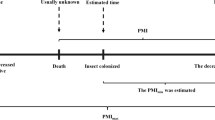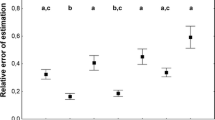Abstract
Measuring temperature is a key factor in forensic entomology. While noting factors to consider for a posteriori temperature estimation, many studies lack detailed methods or general rules allowing their integration into insect development-time calculations. This article proposes tools for determining the adequacy of weather station temperature datasets versus the local temperature experienced by carrion breeders. The idea is to start from a local scale (i.e., the cadaver) and gradually move to larger scales: at each step, the temperature can be increased, decreased or smoothed by environmental or biological factors. While a one-size-fits-all solution is not feasible for a complex and sensitive issue such as forensic meteorology, this checklist increases the reliability of minimum post-mortem interval (PMImin) estimation and the traceability of the proposed assumption.

Similar content being viewed by others
References
Smith KGV (1986) A manual of forensic entomology. Trustees of the British Museum (Natural history), London
Byrd DJH, Castner JL (2009) Forensic entomology: the utility of arthropods in legal investigations, 2nd revised edition. CRC Press Inc, Boca Raton, p 705
Amendt J, Campobasso CP, Gaudry E et al (2006) Best practice in forensic entomology—standards and guidelines. Int J Legal Med 121:90–104. https://doi.org/10.1007/s00414-006-0086-x
Archer MS (2004) The effect of time after body discovery on the accuracy of retrospective weather station ambient temperature corrections in forensic entomology. J Forensic Sci 49:553–559
Hofer IMJ, Hart AJ, Martín-Vega D, Hall MJR (2017) Optimising crime scene temperature collection for forensic entomology casework. Forensic Sci Int 270:129–138. https://doi.org/10.1016/j.forsciint.2016.11.019
Weatherbee CR, Pechal JL, Stamper T, Benbow ME (2017) Post-colonization interval estimates using multi-species Calliphoridae larval masses and spatially distinct temperature data sets: a case study. Insects 8:40. https://doi.org/10.3390/insects8020040
Higley LG, Haskell N (2001) Insect development and forensic entomology. In: Byrd JH, Castner JL (eds) Forensic entomology. The utility of arthropods in legal investigations. CRC Press LLC, Boca Raton, pp 287–302
Ames C, Turner B (2003) Low temperature episodes in development of blowflies: implications for postmortem interval estimation. Med Vet Entomol 17:178–186. https://doi.org/10.1046/j.1365-2915.2003.00421.x
Marchenko MI (2001) Medicolegal relevance of cadaver entomofauna for the determination of the time of death. Forensic Sci Int 120:89–109. https://doi.org/10.1016/S0379-0738(01)00416-9
Abdullah SR, Omar B, Bashah RMZRK, Nor FM, Swarhib MS, Othman HF, Wahid SA (2015) Forensic entomology of high-rise buildings in malaysia. Trop Biomed 32(2):291–299
Ikemoto T, Egami C (2013) Mathematical elucidation of the Kaufmann effect based on the thermodynamic SSI model. Appl Entomol Zool 48:313–323. https://doi.org/10.1007/s13355-013-0190-6
Worner SP (1992) Performance of phenological models under variable temperature regimes: consequences of the Kaufmann or rate summation effect. Env Entomol 21:689–699
Henssge C, Madea B (2007) Estimation of the time since death. Forensic Sci Int 165:182–184
Bourel B, Callet B, Hédouin V, Gosset D (2003) Flies eggs: a new method for the estimation of short-term post-mortem interval? Forensic Sci Int 135:27–34. https://doi.org/10.1016/S0379-0738(03)00157-9
Mall G, Hubig M, Eckl M et al (2002) Modelling postmortem surface cooling in continuously changing environmental temperature. Leg Med 4:164–173. https://doi.org/10.1016/S1344-6223(02)00013-5
Huntington TE, Higley LG, Baxendale FP (2007) Maggot development during morgue storage and its effect on estimating the post-mortem interval. J Forensic Sci 52:453–458
Johnson AP, Mikac KM, Wallman JF (2013) Thermogenesis in decomposing carcasses. Forensic Sci Int 231:271–277. https://doi.org/10.1016/j.forsciint.2013.05.031
May (1979) Insect thermoregulation. Annu Rev Entomol 24:313–349
Sharanowski BJ, Walker EG, Anderson GS (2008) Insect succession and decomposition patterns on shaded and sunlit carrion in Saskatchewan in three different seasons. Forensic Sci Int 179:219–240
Podhorna J, Aubernon C, Borkovcova M et al (2017) To eat or get heat: behavioral trade-offs between thermoregulation and feeding in gregarious necrophagous larvae. Insect Sci. https://doi.org/10.1111/1744-7917.12465
Aubernon C, Boulay J, Hédouin V, Charabidzé D (2016) Thermoregulation in gregarious dipteran larvae: evidence of species-specific temperature selection. Entomol Exp Appl 160:101–108. https://doi.org/10.1111/eea.12468
Charabidze D, Bourel B, Gosset D (2011) Larval-mass effect: characterisation of heat emission by necrophageous blowflies (Diptera: Calliphoridae) larval aggregates. Forensic Sci Int 211:61–66. https://doi.org/10.1016/j.forsciint.2011.04.016
Heaton V, Moffatt C, Simmons T (2014) Quantifying the temperature of maggot masses and its relationship to decomposition. J Forensic Sci 59:676–682. https://doi.org/10.1111/1556-4029.12396
Johnson AP, Wighton SJ, Wallman JF (2014) Tracking movement and temperature selection of larvae of two forensically important blow fly species within a “maggot mass”. J Forensic Sci 59:1586–1591. https://doi.org/10.1111/1556-4029.12472
Kotzé Z, Villet MH, Weldon CW (2016) Heat accumulation and development rate of massed maggots of the sheep blowfly, Lucilia cuprina (Diptera: Calliphoridae). J Insect Physiol 95:98–104. https://doi.org/10.1016/j.jinsphys.2016.09.009
Rivers DB, Thompson C, Brogan R (2011) Physiological trade-offs of forming maggot masses by necrophagous flies on vertebrate carrion. Bull Entomol Res 101:599–611. https://doi.org/10.1017/S0007485311000241
Heaton V, Moffatt C, Simmons T (2018) The movement of fly (Diptera) larvae within a feeding aggregation. Can Entomol 150:1–8. https://doi.org/10.4039/tce.2018.9
Heaton V (2014) Modelling the thermodynamics of maggot masses during decomposition. Dissertation, University of Central Lancashire
Ceciliason A-S, Andersson MG, Lindström A, Sandler H (2018) Quantifying human decomposition in an indoor setting and implications for postmortem interval estimation. Forensic Sci Int 283:180–189. https://doi.org/10.1016/j.forsciint.2017.12.026
MacMaster G (2006) Environmental forensics and its effects on investigations. PageFree Pub, Otsego
Scala JR, Wallace JR (2009) Forensic meteorology: the application of weather and climate. In: Forensic entomology the utility of arthropods in legal investigations, Second edn. CRC Press, Boca Raton, pp 519–538
Henssge C (1992) Rectal temperature time of death nomogram: dependence of corrective factors on the body weight under stronger thermic insulation conditions. Forensic Sci Int 54:51–66
Amendt J, Richards CS, Campobasso CP et al (2011) Forensic entomology: applications and limitations. Forensic Sci Med Pathol 7:379–392. https://doi.org/10.1007/s12024-010-9209-2
Bugelli V, Toni C, Domenici R, Vanin S (2013) Meteorological data: “non proximus sed similis”. Presentation, 9th European association for Forensic Entomology annual meeting, Coimbra, Portugal
Dourel L, Pasquerault T, Gaudry E, Vincent B (2010) Using estimated on-site ambient temperature has uncertain benefit when estimating postmortem interval. Psyche J Entomol 2010:1–7. https://doi.org/10.1155/2010/610639
Johnson AP, Wallman JF, Archer MS (2012) Experimental and casework validation of ambient temperature corrections in forensic entomology*,†. J Forensic Sci 57:215–221. https://doi.org/10.1111/j.1556-4029.2011.01900.x
Dabbs GR (2015) How should forensic anthropologists correct National Weather Service Temperature Data for use in estimating the postmortem interval? J Forensic Sci 60:581–587. https://doi.org/10.1111/1556-4029.12724
Barry RG, Blanken PD (2016) Microclimate and Local Climate. University Press, Cambridge
Archer MS, Jones SD, Wallman JF (2017) Delayed reception of live blowfly (Calliphora vicina and Chrysomya rufifacies) larval samples: implications for minimum postmortem interval estimates. Forensic Sci Res 3:1–13. https://doi.org/10.1080/20961790.2017.1408550
Thevan K, Ahmad AH, Rawi CSM, Singh B (2010) Growth of Chrysomya megacephala (Fabricius) maggots in a morgue cooler. J Forensic Sci 55:1656–1658. https://doi.org/10.1111/j.1556-4029.2010.01485.x
Bugelli V, Campobasso CP, Verhoff MA, Amendt J (2017) Effects of different storage and measuring methods on larval length values for the blow flies (Diptera: Calliphoridae) Lucilia sericata and Calliphora vicina. Sci Justice 57:159–164
Gaudry E, Dourel L (2013) Forensic entomology: implementing quality assurance for expertise work. Int J Legal Med 127:1031–1037. https://doi.org/10.1007/s00414-013-0892-x
Author information
Authors and Affiliations
Corresponding author
Ethics declarations
Competing interests
The authors declare that they have no conflict of interest.
Rights and permissions
About this article
Cite this article
Charabidze, D., Hedouin, V. Temperature: the weak point of forensic entomology. Int J Legal Med 133, 633–639 (2019). https://doi.org/10.1007/s00414-018-1898-1
Received:
Accepted:
Published:
Issue Date:
DOI: https://doi.org/10.1007/s00414-018-1898-1




